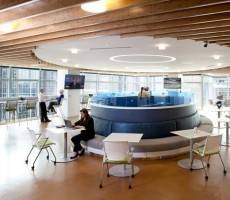October 3, 2014
Julian Assange escapes incarceration to take part in conference as a hologram
[embedplusvideo height=”200″ width=”230″ editlink=”https://bit.ly/1x5tY4Y” standard=”https://www.youtube.com/v/3EjcSc_44vE?fs=1&vq=hd720″ vars=”ytid=3EjcSc_44vE&width=230&height=200&start=&stop=&rs=w&hd=1&autoplay=0&react=0&chapters=¬es=” id=”ep1089″ /]
We have grown accustomed to the way technology distorts time and space. This, after all, is the underlying tension that defines each of the major debates about the workplace, including flexible working, office design, facilities management and the acquisition of commercial property. But, as they say, we ain’t seen nothing yet as the next generation of technologies starts to scale the upslope of the diffusion of innovation curve. People have been talking about telepresence for a little while, but it is about to achieve mainstream awareness thanks to events such as the appearance of Wikileaks Founder Julian Assange at a conference in the USA last week. Assange is famously holed up in London in the Ecuadorian Embassy, challenging his extradition to Sweden to face trial and can’t leave the building without being arrested. So the way he appeared at the conference in Nantucket was as a hologram.











 Avanta Serviced Office Group has signed a deal to establish a new business centre in the heart of London’s Tech City at The Eagle, a 27 storey art-deco-style development on City Road, EC1, from Mount Anvil – Central London’s specialist residential-led developer. The centre is set to open on the 1st March 2015. The new centre will provide over 26,000 square feet of flexible office space over two floors, with approximately 400 desks. Set within a mixed-use development comprising retail, affordable accommodation, offices and high-end residential, it is located within TFL’s Zone 1, approximately five minutes’ walk from Old Street Rail and Underground Station, just two stops from Kings Cross.bThis is Avanta’s first site within Tech City, also known as Silicon Roundabout, which is the third largest technology start-up cluster in the world and home to over 15,000 growing businesses.
Avanta Serviced Office Group has signed a deal to establish a new business centre in the heart of London’s Tech City at The Eagle, a 27 storey art-deco-style development on City Road, EC1, from Mount Anvil – Central London’s specialist residential-led developer. The centre is set to open on the 1st March 2015. The new centre will provide over 26,000 square feet of flexible office space over two floors, with approximately 400 desks. Set within a mixed-use development comprising retail, affordable accommodation, offices and high-end residential, it is located within TFL’s Zone 1, approximately five minutes’ walk from Old Street Rail and Underground Station, just two stops from Kings Cross.bThis is Avanta’s first site within Tech City, also known as Silicon Roundabout, which is the third largest technology start-up cluster in the world and home to over 15,000 growing businesses.


 Just a few days ago,
Just a few days ago, 








September 16, 2014
The culture of presenteeism is not all just fun and games
by Mark Eltringham • Comment, Flexible working, Workplace, Workplace design
(more…)